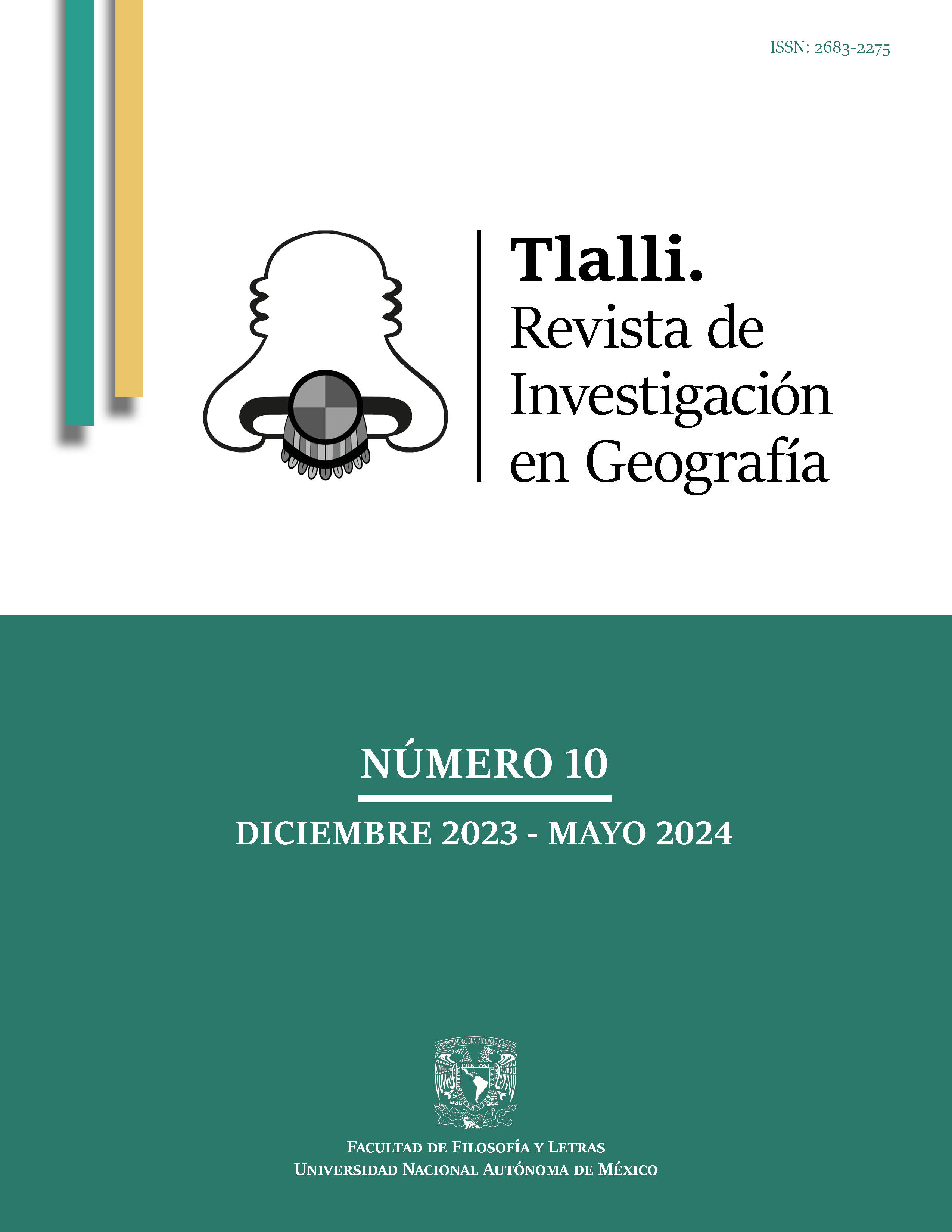Chinantec Nomenclature and the Social Function of the Microtoponymy in Santiago Comaltepec, Oaxaca
Main Article Content
Abstract
The Chinantec community of Santiago Comaltepec, Ixtlán, Oaxaca, in Mexico, has a high density of “microtoponyms” that refer to small parts within the population, which divide a surface of 35 hectares into at least 56 small parts, to such a degree that often the name of a place corresponds to an area inhabited by one or two families. In this study, we document such microtoponyms through oral histories recorded in a collection of linguistic documentation, and we analyze their linguistic structure as well as the ontological correspondence between the physiographic terms and the actual environment. In this way, we demonstrate that i) the Chinantec microtoponyms of Santiago Comaltepec include more than twenty terms with unknown etymology; ii) most microtoponyms are formed around a term for relief or monument, rather than flora and fauna or other types of environmental information; iii) microtoponyms form a closed lexical subclass that is distinguished from momentary descriptions of places in terms of location relative to a monument; and iv) microtoponyms have the function of identifying individuals and are used at different moments of social life in Santiago Comaltepec. Subsequently, we describe the nomenclature of minor place names that differ from microtoponyms in i) including additional terms of relief that refer to large landforms, ii) frequently including terms for flora and fauna, and iii) including terms that describe climatic conditions. The result highlights the importance of linguistic and social perspectives to study toponyms in general.
Article Details

This work is licensed under a Creative Commons Attribution-NonCommercial-NoDerivatives 4.0 International License.
References
Ameka, Felix K.; Levinson, Stephen C. (2007). “Introduction: The Typology and Semantics of Locative Predicates: Posturals, Positionals, and Other Beasts”. Linguistics, 45(5part6), 847-871. https://doi.org/10.1515/LING.2007.025.
Anderson, Judith Lynn. (2018). Gramática del chinanteco de Comaltepec, Oaxaca. Instituto Lingüístico de Verano.
Anderson, Judith Lynn; Goodwin de Montague, Diane; Pace de Davies, Wanda (Comps.). (2021). Diccionario chinanteco de Santiago Comaltepec, Ixtlán de Juárez, Oaxaca. Instituto Lingüístico de Verano.
Brown, Penelope. (2008). “Up, down, and across the Land: Landscape Terms, Place Names, and Spatial Language in Tzeltal”. Language Sciences, 30(2-3), 151-181. https://doi.org/10.1016/j.langsci.2006.12.003.
Burenhult, Niclas; Levinson, Stephen C. (2008). “Language and Landscape: A Cross-linguistic Perspective”. Language Sciences, 30(2-3), 135-150. https://doi.org/10.1016/j.langsci.2006.12.028.
Castillo Martínez, Rafael. (2012). El sistema tonal del chinanteco de San Juan Quiotepec, Oaxaca (Tesis de maestría, Centro de Investigaciones y Estudios Superiores en Antropología Social, México). Recuperada de http://ciesas.repositorioinstitucional.mx/jspui/handle/1015/834.
Castillo Martínez, Rafael. (2022). Fu chi, fuu goo. Quiotepec, mi pueblo. Instituto Nacional de Pueblos Indígenas.
Doesburg, Sebastián van; Swanton, Michael W. (2011). “Mesoamerican Philology as an Interdisciplinary Study: The Chocho (Xru Ngiwa) “Barrios” of Tamazulapan (Oaxaca, México)”. Ethnohistory, 58(4), 613-652. https://doi.org/10.1215/00141801-1333688.
García, Eleuterio Xagaat. (2019). ¿Ni tï juu ki’i? ¿Acertarás?. Secretaría de Cultura; Instituto Nacional de Lenguas Indígenas.
García Hernández, Eleuterio; López Luna, Vilma (Coord). (2020). Vocabulario chinanteco de la zona alta: guía de escritura. Jefatura de zonas 03, Guelatao.
Gómez López, Nelva. (2018). Rupturas y continuidades en la transmisión intergeneracional de la lengua y cultura chinanteca en niños menores de cinco años de Mo’ia, Oaxaca, México (Tesis de maestría, Universidad Mayor de San Simón, Bolivia). Recuperado el 14 de junio de 2023 de http://ddigital.umss.edu.bo:8080/jspui/handle/123456789/10348.
Hernández López, Pedro. (2000). Juu kii’, palabra nuestra: hacia la escritura del chinanteco de la sierra norte de Oaxaca. Centro de Estudios y Desarrollo de las Lenguas Indígenas de Oaxaca.
Inali [Instituto Nacional de Lenguas Indígenas]. (2008, 14 de enero). Catálogo de lenguas indígenas nacionales: variantes lingüísticas de México con sus autodenominaciones y referencias geoestadísticas. En Diario Oficial de la Federación. https://www.inali.gob.mx/pdf/CLIN_completo.pdf.
Inegi [Instituto Nacional de Estadística y Geografía]. (2020). Censo de población y vivienda. Recuperado el 28 de mayo de 2023 de https://www.inegi.org.mx/app/mapa/espacioydatos/default.aspx?ag=204580001.
IPA [International Phonetic Association]. (2015). IPA Chart. http://www.internationalphoneticassociation.org/content/ipa-chart.
Levinson, Stephen C. (2003). Space in Language and Cognition. Cambridge University Press. https://doi.org/10.1017/CBO9780511613609.
Nakamoto, Shun; Hernández López, Israel. (2023a). Demostrativos en el chinanteco de Comaltepec [Manuscrito enviado para publicación].
Nakamoto, Shun; Hernández López, Israel. (2023b). A Textual Documentation of Comaltepec Chinantec Ethnoecology and Toponymy [Manuscrito en preparación]. The Whatcom Museum, Bellingham, Washington.
O’Meara, Carolyn. (2010). Seri Landscape Classification and Spatial Reference (Tesis doctoral, University at Buffalo, the State University of New York, Estados Unidos de América). Recuperado el 14 de junio de 2023 de https://arts-sciences.buffalo.edu/content/dam/arts-sciences/linguistics/AlumniDissertations/Omeara%20dissertation.pdf.
Pace, Wanda Jane. (1990 [1977]). “Comaltepec Chinantec Verb Inflection”. En William R. Merrifield y Calvin R. Rensch (Eds.), Syllables, Tone, and Verb Paradigms. Studies in Chinantec Languages 4. The Summer Institute of Linguistics; The University of Texas at Arlington.
Pulido Secundino, Juan; Bocco Verdinelli, Gerardo. (2016). “Conocimiento tradicional del paisaje en una comunidad indígena: caso de estudio en la región purépecha, occidente de México”. Investigaciones Geográficas, (89), 41-57. https://doi.org/10.14350/rig.46478.
Rensch, Calvin R. (1989). An Etymological Dictionary of the Chinantec Languages. Studies in Chinantec Languages 1. The Summer Institute of Linguistics; The University of Texas Arlington.
Reyes Contreras, Miguel. (2022). “El saber ancestral sobre el paisaje: toponimia mazahua del Barrio de Tlalpujahuilla, Ixtlahuaca, México”. Onomástica desde América Latina, 3(5), 127-143. https://doi.org/10.48075/odal.v3i5.28950.
Rybka, Konrad. (2015). “Between Objects and Places: The Expression of Landforms in Lokono (Arawakan)”. International Journal of American Linguistics, 81(4), 539-572. https://doi.org/10.1086/683159.
Smith, Barry; Mark, David M. (2003). “Do Mountains Exist? Towards an Ontology of Landforms”. Environment and Planning B: Urban Analytics and City Science, 30(3), 411-427. https://doi.org/10.1068/b12821.
Tallè, Cristiano. (2019). Tiül miiüt, tiül mindek mixejchiiüts: en la tierra y en las lagunas de nuestros antepasados. Atlas de los nombres de lugares de los Ikoots de San Mateo del Mar. Instituto Nacional de Lenguas Indígenas.
Tent, Jan. (2015). “Approaches to Research in Toponymy”. Names, 63(2), 65-74. https://doi.org/10.1179/0027773814Z.000000000103.
Villette, Julia; Purves, Ross, S. (2020). “From Microtoponyms to Landscape Using Semantics, Location, and Topography: The Case of Wald, Holz, Riet, and Moos in St. Gallen, Switzerland”. The Professional Geographer, 72(1), 109-120, https://doi.org/10.1080/00330124.2019.1653772.

